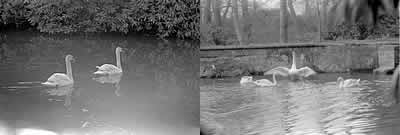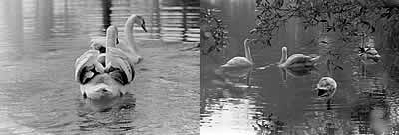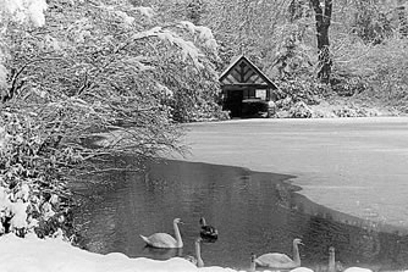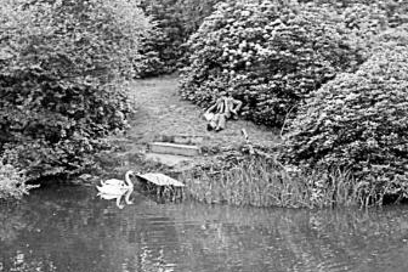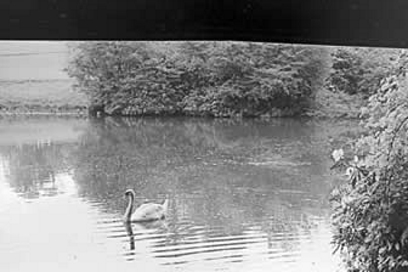Swans, Swanmasters, Swanmistresses - and a cygnet!
Swans were an important part of the scenery at Keele from the beginning and the Swanmaster and Swanmistress had both an honorary and a practical role in the Students' Union.
Although swans have not graced the Keele lakes since the 1980s, ducks and geese have more than made up for their absence. The office of Swanmaster or Swanmistress is conferred on only one student (or rarely, a staff member) each year – by the Students’ Union President – in recognition of a student who has contributed significantly to the spirit and community of Keele without necessarily holding a formal post or office.
Photo: John Mack (1961) and friends appreciate a Keele swan.
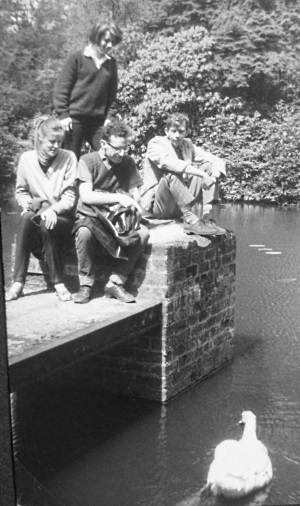
"During my nine months at UCNS when I was age 21, I remember a candle-lit dinner. As I recall, I was told that it was the second one, and served to create a tradition from the previous year, when candles were required when the electricity went out. I remember being amused at this English desire to have traditions, and that a 4-year-old college used any unusual event, including an electricity outage, to create "A Tradition". I also remember the Swanmaster, an office which was created either that year or the year before. I don't recall what were the duties of the Swanmaster, other than there being no Leda-like obligations with the swans. I remember that there were a few swans on the pond. I don't remember who was Swanmaster, but seem to remember that he looked like a man named Gordon Swann whom I met some years later at the University of Chicago. That year, there was a "Swanmaster's Debate", designed to create "A Tradition". The participants were the President of the Union, the Swanmaster (wearing a specially-designed gown with swans embroidered on it), a third person, and me. The debate topic was "Scientific Curiosity is the Enemy of the Individual", or that might have been the debate topic of another debate that year."
Ron Decker Swarthmore Exchange Student to Keele (1953-54)
Known list of Swanmasters and Swanmistresses
1952 Brian Dunning / 1953 Tom Parry / 1954 John E Thomas / 1955 Cordelia Goodway (Lamb) / 1956 ? / 1957 Peter Young / 1958 John Periton / 1959 Denis Delay / 1960 Christopher “Ticker” Hayhurst / 1961 Sheila Everard / 1962 Alan Berry / 1963 ? / 1964 Chris Reiss / 1965 Sue Lyth / 1966 ? / 1967 Roger Evans / 1968 ? / 1969 Clare Radstone (Woodward) / 1970 - 1975 ? / 1976 Philip Carney / 1977-1970 ? / 1980 Anna Summerskill and Andy Downie / 1981 - 1987 ? / 1988 Richard Bettsworth / 1989 ? / 1990 Helen Mills & Nikki Greenway / 1991-1994 ? / 1995 Amanda Hatton (Jempson) / 1995 - 2010 ?
Revived 2010: 2010 Edward Youngman / 2011 Chris Dillon / 2012 Makinder Chahal / 2013 Professor Marilyn Andrews / 2014 Emma Carter / 2015 Ela Hollies / 2016 Ceri Smith / 2017 Alice Williams / 2018 Margaret Afekafe / 2019 George Blake / 2020 Adam Goodwin / 2021 Alana Wheat
We would love to fill in the gaps.... please contact Alumni HQ if you can help.
How the swans and the Swanmaster came to Keele
From the Introduction to the Swanmaster's Debate 1955 by President of the Students' Union, Bill Hanna, for the Inauguration of Keith Clement as Swanmaster:
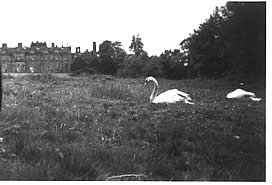
"I feel that before the new Swanmaster is invested with the insignia of his office, I should very briefly trace the story that lies behind this ceremony. The office of Swanmaster is a non-elective one; it lies in the gift of the President of the Union, and it is conferred for meritorious service. There is no reason why the office should not, if appropriate, be filled by a Swanmistress. I'm sure Mr Clement will be glad to know that no sex bar attaches to his office.
In Coronation Year, Mr Brian Dunning, who was then a member of this Union, originated the idea that the Union give a pair of swans to the College. He wrote to the Lord Chamberlain, who replied that Her Majesty was graciously pleased to give two swans to Keele. Mr Dunning then got in touch with a Mr Turk who held the post of Chief Swan Upper. Before Mr Turk could be induced to part with two of his charges, he required an undertaking signed by a responsible person to the effect that the waters would be adequate for the accommodation of the birds:
Professor Gemmell gave the necessary guarantee, and at the end of the summer term, two crated swans were delivered to Keele. At the beginning of the next term, Mr Dunning was made Swanmaster. His two bits of fluff settled down and were apparently a very happy and loving pair, a circumstance which seemed to bode well for the future.
But unhappily in the spring term the female left. Appeals in the press produced more than eighty replies, letters, telegrams and phone calls from observers who had seen our swan. About half of them showed some idea of the direction taken, and these directions were plotted on a chart.
Eventually, a swan was reported on a pool of dirty water near a slag heap in Stoke. The RSPCA were contacted and an inspector tried to capture the bird. After some trouble, Mr Dunning spotted an old man picking coal off the slag heap. He went over to him, explained the situation, and asked if the old man had, by any chance, a net on him. The old man replied, naturally enough, that he had, he took off his muffler, shook it out, and it was in fact a net. With this, the swan was easily captured. On returning the net, Mr Dunning asked the old man's name and was astonished to hear the reply, 'My name is Sneyd'. Everyone thought that this was a most happy coincidence. And so at first, it was.
Though there was no positive proof of identity, the cob accepted his new mate, and the Swanmaster settled down to listen for the patter of tiny flippers. But no offspring appeared, no fluffy cygnets, not even on the higher purchase - you know - a little down. This was the state of affairs when Mr Parry took office as Swanmaster. The following spring the good lady again departed. With the assistance of Mr Derek Ellis and his Austin Seven, the Swanmaster recovered a female swan from a waterworks fourteen miles off. This swan was brought back to Keele and put on ice - the lake was frozen- but in addition to this fundamentally chilly aspect of her return, she encountered too, the dislike of the old cob, and was driven to a lower lake. The Swanmaster's constant attentions could not entice her to stay, and after two days she flew away. Mr Parry and the Union were most upset, the Swanmaster contemplating suicide and the Union thinking of parricide. This is the background of the ceremony: older members can vouch for the truth of the story.
The Swans have captured the imagination of Keele; the swans have become a symbol and an emblem. It is most fitting therefore that the occasion of the inauguration of the Swanmaster is a solemn ceremony."
Assured by Bill Hanna (1957) and Pauline Hanna (Jones) (1959): "probably better heard than read."
More Swanmasters and Swanmistresses
"The first person to hold the high office of Swanmaster was Tom Parry in 1954. A year later I took over and in 1956 I handed over to Peter Young. The investiture was carried out with unbelievable pomp and jargon and involved insignia and gowns and solemn undertakings. In those early days we never lost an opportunity to invent tradition. After the ceremony there was a debate. Debates in the fifties were very popular and I believe the standard was high although memory may be deceiving me. The duties of the swanmaster merely involved keeping an eye on them - there were two on the top lake. If the water froze, attempts were made to break it up so they could swim. Bread was occasionally thrown. They were bad tempered creatures so I largely kept my distance. But in my year of office there was a moment of high drama. One of the swans was found dead several fields away. There was no explanation. I had to remove the corpse and bury it. We then decided to apply for a replacement. This meant a letter to the Lord Chamberlain since, of course, swans belong to the Queen. After protracted negotiations, a new swan in a wooden crate arrived at Stoke Station. I got it up to Lakeside and introduced it to its new environment. The solitary incumbent was not friendly towards the newcomer for a long time but I think they eventually lived together in harmony. We never did find out the sex of either of them which was probably the problem."
Keith Clement (1956)
Photo above: Ticker Hayhurst in full regalia
"It is recorded that Brian Dunning (1954) was the first Swanmaster of the University College of North Staffordshire."
John Easom (1981)
"In my years 1955-59, Denis Delay was a Swanmaster - a mature student who was colourful, to say the least. He was a dockers’ union man and was well-loved by all who knew him Another was Sheila Everard - I think in 1957-61 or 62 and another well-loved character."
Dot Bell (Pitman) (1959)
The Swanmaster sash was awarded in the early years and the glorious sash pictured below, left, was given to the University in 2013 by the family of the late Denis Delay (1959), one-time Swanmaster.
"Briefly, the Swanmaster was chosen by the President of the Union and was usually someone who had contributed to the life of the Union. The Swanmaster's tie was originally worn by the Swanmaster, the President of the Union and (we think) the Union Committee. We have retrieved Bill’s tie from the back of the wardrobe, it is navy blue, with small silver swans facing to the right. As Vice President I was given a small broach with a swan on it by Mrs Blake (wife of Professor John Blake, acting Principal) who felt that women should not be ignored!"
Bill Hanna (1957) and Pauline Hanna (Jones) (1959)
"As for the Swan tie - I think originally only the Swanmaster had the right to wear it. I lost mine long ago. I was last lakeside at the end of May. There was a wedding party on the terrace and a messy barbecue by the lake. No swans and no water really. It is hard not to be grumpy."
Keith Clement (1956)
Photo right: Ticker feeds the swans
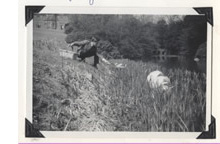
"There were four swans on the lakes in 1959. I went out to feed `em every morning. Sundays it may have been afternoon. One of the groundsmen (Alfred) fed them during the vacs. I have a picture of one of the swans and yours truly in spring 1960. He was a big fiery old male. He was a handful and we had to call the RSPCA once or twice because he attacked the others, and in one case broke one of their wings. There is a story that one of the swans was killed as a result of a magic session! A swan was killed during my time as Swan Master, but I can’t remember the details . I also have a photo of me in Swanmaster’s regalia - my Mother who thought I looked quite smart. I think she used it to impress friends with how brainy I was."
Ticker Hayhurst (1960)
"I encountered an aggrieved swan on the occasion we put Cyrano (the dragon, so named in our day because he has a large nose) on the rocks in the top lake. At certain times of the year, it was best to walk carefully on the top lawns. The swans seemed happy enough. I can also remember seeing swans and geese flights in the autumn over the land towards where the M6 now drones, from whence to where I have no idea."
Ned Lusher (1960)
Photo left: This photo must be one of the earliest, taken by Ron Decker (1954), an American exchange student to Keele from Swarthmore, 1953-1954
"The traditional investiture of the Swanmaster certainly continued. The Union Constitution which operated in a newly-revised form between 1965 and at least 1968 included a separate section concerning the appointment by the Union President of the Swanmaster or Swanmistress, who was to be "guardian of the Keele swans and all the wildlife of the Keele waterways". I have the Union Handbook for 1967-68, in which Sam Nolutshungu advertised the forthcoming Swanmaster's Debate, including the traditional ceremony (handbooks for previous years similarly refer to it). Whether this actually happened in that year, I don't recall amidst all the memories of sit-ins, occupations and strikes. But I would be most surprised if Sam had failed to pull it off. Perhaps 1967-68 was the last gasp, however. In the 1969-70 Handbook the incoming Debates Union President, Len Statham, describes the previous year as "dismal and pathetic"; and while he obviously hopes that the DU will rise "phoenix-like ... from the ashes" he displays some uncertainty about whether it will be able to overcome both "apathy" and "the attacks of those who see it as just another inept manifestation of bourgeois irrelevance". Significantly, no further mention is made of the swans or their Master (who would no doubt have all been relegated to the latter category). Whether and for how long the tradition continued is perhaps a matter which should be referred to the adjudication of the wider clientele of the general alumni list! I have a vague recollection that sometime in the mid-1960's the swans disappeared from the campus to much consternation and were eventually found practising low-flying and take-off and landing techniques on the freshly laid tarmac of the as-yet unopened M6. But perhaps this is merely a fancy of the memory."
Bill Proctor (1968)
"I was made a swanperson in the late 1980s. As you say, it was purely an honorary title and didn't involve me actually having to do anything although I was presented with a pair of green wellies and a keele scarf with a swan logo on it."
Richard Bettsworth (1988)
"I just looked at your list of swan masters/mistresses. I was one for my final year in 1990/1991 - unusually we had two that year (me and Helen Mills)."
Nikki Greenway (1991)
The swans - and a cygnet
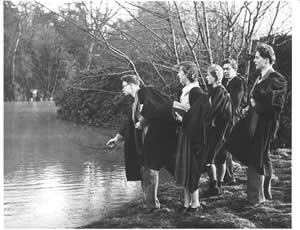
"When I arrived at Keele in the Autumn of 1954, there was no student newspaper. That didn’t seem right, even though there were only about 600 undergraduates, and not much news. So I started one, and the first edition came out in the early summer of 1955. I called it The Cygnet to end speculation about whether and when the Keele swans would ever produce offspring.
Much sorrow has been expressed about the absence of swans from Keele. They were definitely not eaten, not even during 1950's rationing - although such a rumour was circulated. Nor were they were subjected to any kind of Quatermass-type chemical experiment. There have been no swans at Keele for many, many years. Presumably the ponds have ceased to provide the food and habitat that swans need to sustain their residence and they just took sorrowful flight one day. Others have suggested that the lakes never had enough take-off and landing space for these majestic creatures. According to one report, it was decided around 1980 that the swans should be moved to the Madeley Pool - there are definitely swans there still and living in a most picturesque setting - but I don't whether that was done or even could be done."
Dave Emley (Keele staff)
"There was a Shakespeare production, The Tempest I think, on the natural apron at the edge of the lake. After many rehearsals, two Keele swans were trained to swim across the lake behind Ceres' barge. They followed her ashore and (not intended in the production) proceeded to copulate. Performance stopped until they stopped. Many of the invited Potteries dignitaries assumed it was a tasteless undergraduate joke about the bounty of Ceres."
Geoff Little (1954)
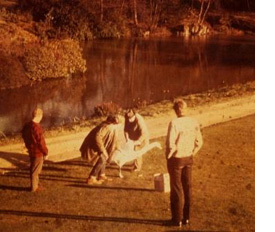
"I've got no recollection of how I got volunteered for the job, but in 1976 or 1977 I helped bring back a swan to the lakes, for a short while at least. Along with one of the SU committee, the two of us went to Madeley to collect a swan from the lake in the middle of the village. Not driving at the time, I had the job of holding the bird and keeping it quiet in the back of the Union minibus and then releasing it on to the top lake nearest Keele Hall. I never realised how big and strong swans actually are, but trying to keep one still for a 10-15 minute journey was not easy. I think it was meant to be a partner for the other swan. As far as I remember it was there for over a year before the swans disappeared."
Paul Frost (1979)
"I was on one of the trips to collect swans from Madeley - I got the short straw for holding it all the way back and releasing it to the lake. I thought Paul Clark (1980) was driving when I went - but maybe it was you, Chris Parkins?"
Paul Frost (1979)
"With the late Anna Summerskill I was Swanmaster in 1980. There were no swans, I wrote to the Queen asking for some. This was reported in the Sentinel, I received a letter from the Palace saying that all the Swans on the Thames belonged to the Queen and that there were none to spare. We received a letter or a call from Madeley Parish council who said we could have three swans if we could pick them up. We used the Student's Union mini van. The swans did not stay long as it was decided that the suggestion that their wings should be clipped was wrong. I seem to remember being contacted by a member of staff some time later to say that one of the swans had been shot, I saw its body in the sports hall."
Andy Downie (1980)
"I think we had just the one minibus in our day. I remember an entire SU committee meeting about replacing it in 1979 - whether to get the same model, which was the best deal, etc. I used to drive it occasionally. I ran the odd 'shuttle' to Victoria Hall when there was an interesting band on; plus we had to go and collect some swans from Madeley once. I think the legendary Anna Summerskill (1981) and Beryl (Helen) Farres (1981) were with me; the swan seemed reasonably happy, playing with my hair from behind."
Chris Parkins (1981)
Photo left: Chris Reiss 1964 with porter Charley Wainwright
"Those swans could be unpredictable. I was walking with a three year old and a baby in a push chair down the grass from Keele Hall towards the top lake (this must have been in early 1969) when a swan came hurtling off the water and rushed towards us, head down and wings outstretched. I grabbed the baby out of the pushchair and fled up the hill with the three year old. The swan had a very determined go at the pushchair. We thought it was the male defending the nest, which was on an island at the top of the lake as far as I recall."
Tessa Harding (Phillips) (1965)
The three swan photos below were provided by John Myatt (1957) and date from 1954 and the winter of 1956.
The four photos below are from 1980 by Paul Frost (1979) - the main change is the absence of the Boat House:
